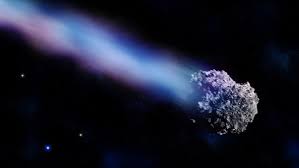
Can Meteoroids Be Composed of Different Materials? Exploring the Diversity of Celestial Objects
Meteoroids, the smaller counterparts of meteorites and meteors, are celestial objects that travel through space. These rocky or metallic fragments vary widely in composition, and indeed, meteoroids can be composed of different materials, including metals, minerals, and even organic compounds. In this extensive article, we will explore the fascinating world of meteoroids, their diverse compositions, and provide examples of some unique and intriguing meteoroids that have captured the imagination of scientists and space enthusiasts alike.
The Composition of Meteoroids
Meteoroids are remnants from the early solar system and can originate from various sources, including asteroids, comets, and planetary bodies. Their composition depends on their origin and history, making them incredibly diverse in terms of materials.
1. Metallic Meteoroids
Some meteoroids are primarily composed of metals, with iron and nickel being the most common constituents. These metallic meteoroids are remnants of the cores of asteroids or other planetary bodies that broke apart due to collisions. Notable examples of metallic meteoroids include:
- Iron Meteoroids: These meteoroids consist mostly of iron and nickel, giving them a distinctive metallic appearance. The Canyon Diablo meteorite is a famous example, with remnants found in Arizona’s Meteor Crater.
- Stony-Iron Meteoroids: Stony-iron meteoroids, as the name suggests, are composed of a mix of metallic and rocky material. The Pallasites, a rare type of meteorite, are a stunning example of this category, with olivine crystals embedded in an iron-nickel matrix.
2. Stony Meteoroids
Stony meteoroids are primarily composed of silicate minerals and rocky material. They are often remnants of the outer layers of asteroids or planetary bodies. These meteoroids come in various subtypes:
- Chondritic Meteoroids: Chondritic meteoroids are among the most primitive objects in the solar system and contain tiny spherical particles called chondrules. They provide crucial insights into the early stages of planetary formation.
- Achondritic Meteoroids: These meteoroids lack chondrules and represent the differentiated crusts or mantles of larger planetary bodies. They often contain minerals like pyroxene and feldspar.
3. Carbonaceous Meteoroids
Carbonaceous meteoroids, often associated with comets and primitive asteroids, contain carbon-based compounds, including organic molecules. These meteoroids are of particular interest to scientists due to their potential role in the delivery of organic matter and water to early Earth. Notable examples include:
- CI and CM Carbonaceous Chondrites: These meteorites contain water and organic compounds, making them valuable for studying the origins of life on Earth. The Murchison meteorite, a CM chondrite, is famous for its rich organic content.
- Tagish Lake Meteoroid: This carbonaceous meteoroid, which entered Earth’s atmosphere in 2000, is a rare example of a pristine, unaltered object from the outer solar system. It contains complex organic compounds.
Implications for Science and Exploration
The diverse composition of meteoroids has significant implications for our understanding of the solar system’s history, planetary formation, and the potential for extraterrestrial life. By studying meteoroids, scientists can gain insights into the conditions of the early solar system and the materials that were present during its formation.
Furthermore, meteoroids offer a unique opportunity for space exploration. Missions like NASA’s OSIRIS-REx and Japan’s Hayabusa2 have visited near-Earth asteroids to collect samples and return them to Earth. These missions aim to provide a better understanding of asteroid composition, which can inform future planetary defense efforts and resource utilization.
Conclusion
Meteoroids, with their diverse compositions and origins, offer a captivating glimpse into the history and makeup of our solar system. From metallic fragments that originated in the cores of shattered asteroids to carbon-rich bodies carrying organic compounds, these celestial objects continue to intrigue scientists and space enthusiasts alike. As our understanding of meteoroids deepens through research and exploration, we are likely to uncover even more secrets about the cosmos and our place within it.
